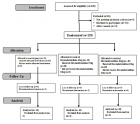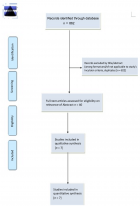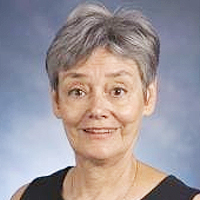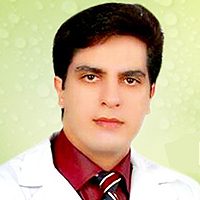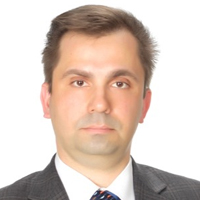About Komi Republican Institute for Development of Education
Komi Republican Institute for Development of Education
Articles by Komi Republican Institute for Development of Education
Diseases of the mental sphere revealed by the psychiatrist at contingent of patients of the consultative outpatient admission
Published on: 9th July, 2019
Introduction: The problem of protecting and strengthening the mental health of the population is the most important task of ensuring the socio-economic well-being of the Komi Republic (RK) as an integral part of the Russian Federation (RF), since it is a key resource for the development of a subarctic region.
The aim of the work: was to characterize diseases of the mental sphere revealed by the psychiatrist at contingent of patients of the consultative outpatient admission at the 1State Autonomous Health Agency of the Republic of Komi “Consultative and Diagnostic Center of the Republic of Komi” (SAHA RK “CDC”) of the subarctic territory.
Materials and methods: The analysis of a continuous sample of 6255 patients of the psychiatrist of the consultative department in 2015-2017 was carried out. on the basis of medical records. Analysis methods included: analytical and statistical. The control group consisted of a continuous sample of 5,356 psychiatric patients in 2010–2012. The depth of the study was 8 years.
Discussion: Trends in changes in demographic indicators, including gender and age, in the structure of patients of a psychiatrist in an outpatient consultative procedure are considered. Indicators of the identified pathology of the mental sphere, including the first identified and pathology in patients suffering from epilepsy in comparison with the control group are given. Attention is paid to the organizational and methodological work of an outpatient counseling psychiatrist on the targeted identification by internists of signs of mental pathology in patients referred to a diagnostic center with somatic diseases. Priorities for the improvement of specialized advisory (including psychiatric) assistance to the population of the RK and ensuring its quality were identified.
Conclusions:
1. The psychiatrist of the advisory department in 2015-2017. 6255 people were accepted (889 more than in the control group of 2010-2012). The increase was 16.78%. Primary patients account for 64.38% of the total number of people who applied to a psychiatrist (4027 people).
2. In the structure of the psychiatric pathology of the outpatient psychiatric appointment, the proportion of organic, including symptomatic, mental disorders (F00-F09) is 47.9±0.6%; neurotic, stress-related and somatoform disorders (F40-F49) - 39.6±0.6%; mental and behavioral disorders associated with the use of psychoactive substances (F10-F19) - 3.5±0.2%; mood disorders (affective disorders) (F30-F39) - 2.8±0.2%.
3. The most frequently detected pathologies in patients with epilepsy are: 1) Mild cognitive impairment; 2) Personality disorders; 3) Organic emotionally labile (asthenic) disorders. Their share annually accounts for 71.5%-75.8% of all types of nosological forms. The fourth and fifth ranking places are taken by: 4) Organic anxiety disorders; 5) Non-psychotic depressive disorders. Rarely diagnoses are established: “Organic Amnesia Syndrome” and “Dementia”.
4. Organic, including symptomatic, mental disorders prevail in the structure of newly discovered mental disorders; neurotic, stress-related and somatoform disorders (up to 87.7%). Mental and behavioral disorders associated with the use of psychoactive substances and mood disorders (affective disorders) do not exceed 8.4%.
Regulatory requirements and assessment of scientific research by a psychiatrist when considering the issue of assigning a qualifying doctor`s category
Published on: 20th April, 2021
OCLC Number/Unique Identifier: 9026724522
Introduction: In accordance with the requirements for the preparation of a report, a physician must provide information on scientific research in the following sections to obtain a qualification category of a specialist: 6. Scientific and practical work (participation in scientific and practical conferences, medical scientific societies, presentations, publications); 11.2. List of publications of the attested in scientific journals and collections, abstracts and 11.3. List of speeches at international, all-Russian and republican conferences.
Material and methods: The analysis of 5 qualification works of a psychiatrist (1997, 2002, 2008, 2013 and 2018) for the scientific component as part of the mandatory requirements for the processing of documents when they are submitted to the Attestation Commission on the assignment of a qualifying medical category in psychiatry . The depth of the study was 24 years. When working on the material, the following methodical approaches were used: system, complex, dynamic, normative, quantitative and situational. Methods of analysis included: historical, analytical and comparison. For the analysis, methods were used: groupings, absolute values, continuous and selective observations.
Results: The psychiatrist GAUZ “KDC” independently or in co-authorship published 223 scientific and educational-methodical publications (total volume of 182.65 conventional author’s sheets), including 90 scientific (39.81) and 143 educational-methodical (142.84) works, in including one monograph and eight textbooks (two of them with the stamp of the Ministry of Education of the Russian Federation). In the e-library (www.e-library.ru) of the Russian Scientific Citation Index (RINC): publications - 31; citations - 123; Hirsch index - 3, publications in the journals of the VAK - 13. (https://elibrary.ru/author).
Discussion: The scientific work of a practicing outpatient psychiatrist is assessed both quantitatively and qualitatively, the integral indicator of the psychiatrist’s own participation in each publication of 0.78 conventional printed sheets can be considered as a serious personal contribution to scientific research.
In the regulatory framework of indicators and requirements for registration of the report there is no synchronization in the daily work of a practical doctor, his job duties with the statements of the report. When concluding an employment contract with the employer, there is no mention in it that the doctor should engage in scientific work, and it is an integral part of his functional duties and qualification requirements. The scientific work does not mention the “Unified qualification directory of positions of managers, specialists and employees, the section “Qualification characteristics of the positions of employees in the field of health care” for a psychiatrist.
Conclusion: The attitude to the Administrative Regulations on the provision of a public service for assigning a qualification category to specialists engaged in medical and pharmaceutical activities should be reviewed in terms of synchronization with the duties of a doctor. The Regulation on the compulsory conduct of scientific research should be introduced, substantiated and provided by the employer or be excluded from the administrative regulations as an independent section and be exclusively recommendatory in nature.
Publications of physicians in scientific journals and collections, theses of reports should motivate their interest, and within the limits of the possibilities of the medical institution to have reasonable financial support, fixed in the employment contract.
An example of a practical doctor who speaks at international, all-Russian or republican congresses, congresses and conferences is an important indicator of his professional growth, an incentive for the disclosure and development of the potential of the medical institution team and the result of proper administrative and organizational-methodological guidance.
The scientific work and publications of a psychiatrist’s practical doctor should be a weighty additional argument in favor of a positive decision on awarding the qualification category he has declared.
Lecture: “First aid to the population for wounds during accidents, сatastrophes, natural disasters, and terrorist attacks” for Humanitarian and Technical Universities
Published on: 19th July, 2019
OCLC Number/Unique Identifier: 9272394938
1. The concept of wounds.
2. Classification of wounds.
3. Signs of wounds.
4. Factors affecting the course of the wound process.
5. Phases of the wound process.
6. Types of wound healing.
7. Features of wounds in children.
8. First (first emergency) help.
9. Complications of wounds.
10. Specific bite wounds. Notion Treatment. Complications.
11. Snake bites. First aid.
12. Arthropod bites. First aid.
Wounds are called traumatic violation of the integrity of the skin or mucous membranes with possible damage to the deeper tissues.
Pediatrics of disasters in the structure of professional training of pediatricians of the city children’s polyclinic to work in emergencies and terrorist acts: View from Russia
Published on: 16th February, 2022
OCLC Number/Unique Identifier: 9427642090
Introduction: Modern pediatrics of disasters is built on 5 basic principles: integrity, structure, causality, dynamism, and hierarchy.Material and methods: Methodological approaches were used: systemic, complex, integration, functional, dynamic, process, normative, quantitative, administrative, and situational, and methods: historical, analytical, and comparison. Techniques were used: grouping, absolute and relative values, detailing, and generalization.Results: The algorithms of actions of the doctor of the children’s clinic in the event of a fire, the receipt of a call about the laying of explosives and the threat of explosion were considered, the scope of the provision of first qualified aid to the pediatric nursing team was clarified. The issues of the organization of the first qualified and specialized medical care, taking into account the anatomical and physiological characteristics of children and adolescents, as well as medical tactics for small-medium, and large disasters in rural areas and cities are discussed.Conclusion: Pediatrics of disasters is an independent section of organizational and medical work in emergencies and terrorist acts, providing specialized medical care for at least 25% of victims, who are children and adolescents. The training of doctors of a specialized children’s polyclinic is regulated by regulatory documents of the Russian Federation and the Republic of Komi, Orders of the Ministry of Health of the region, a municipal formation, and a medical institution in the field of civil defense and emergency situations. In case of minor emergencies and disasters within the city boundaries with the occurrence of a single or a small number of group losses, medical support repeats that in road traffic accidents, with the exception of the organization and conduct of medical triage. In rural areas, it is required to attract additional medical and nursing teams (emergency medical aid teams), created on the basis of medical institutions of the victim and neighboring areas. At the same time, a forced maneuver by the forces and means of territorial health care is necessary for the medical evacuation of a significant part of the affected children to specialized institutions (departments) located in cities. The provision of psychological and psychiatric assistance to children and adolescents in emergencies is carried out on the basis of its basic modules (departments and offices of psychological and psychiatric assistance, and advisory mobile team of psychological and psychiatric assistance, anonymous psychological and psychiatric assistance by telephone).
Organizational and methodological aspects of the work of a psychiatrist on a qualification category. Current status and prospects of psychiatric care in Russia
Published on: 16th February, 2022
Introduction: Preparing a report and passing certification for a qualification category is one of the forms of improving the professional level of each medical worker.Material and methods: The analysis of 5 qualification works of a psychiatrist (1997, 2002, 2008, 2013, and 2018) was carried out for the mandatory requirements for the preparation of documents when they were submitted to the Attestation Commission on the assignment of a qualifying medical category in psychiatry and formation methodological approaches to their implementation. The depth of research was 27 years.Results: Methodological approaches to the design of 11 mandatory sections provided for in the certification work of a psychiatrist presented for the award of a qualification category were considered.Discussion: The attitude to the Administrative Regulations for the provision of state services for the assignment of a qualification category to specialists engaged in medical and pharmaceutical activities should be revised in terms of its synchronization with the official duties of a doctor.Conclusion: The dynamic development of the regulatory, organizational, methodological, and scientific aspects of medicine and psychiatry, in particular, in the period of active digitalization of healthcare, requires periodic corporate discussion and correction of the Administrative Regulations for the provision of public services for assigning a qualification category to specialists engaged in medical and pharmaceutical activities.Attention should be paid to the insufficient statistical processing of the submitted materials by applicants for the assignment of the 1st and highest categories, the lack of calculations, references, and comparisons of confidence intervals, and the reliability of the study.Preparing a report and passing certification for a qualification category can be the first step in introducing a practitioner to scientific work through the generalization of personal work experience, worthy of speaking at a scientific and practical conference at the level of LU and the region and publishing abstracts in collections and scientific and practical journals.The proposed methodological approaches are purely advisory in nature and can be used by psychiatrists when working on a qualification category at their discretion.
An Individual Rehabilitation and/or Habilitation Program for Children with Disabilities (IPRH)
Published on: 23rd January, 2024
Introduction: The individual program of rehabilitation and (or) habilitation of children with disabilities (IPRH) is mandatory for execution by the relevant state authorities, local self-government bodies, as well as organizations regardless of organizational-legal forms and forms of ownership.Objective: To conduct a pilot analysis of the implementation of the IPRH contingent of patients of children with disabilities in an urban children’s clinic.Patients and methods: There were 366 reports on the implementation of measures provided for by an IPRH for a disabled person (disabled child) of 222 disabled. The organization of the study was in the nature of a continuous sample. The criterion for the inclusion of patients in it was the passage of an IPRH in a disabled child within a specified time frame. The following techniques were used: grouping, absolute and relative values, average values, detailing, and generalization. The threshold error probability for statistically significant differences was set at a level of 0.05.Results: The structure of the results of the control of the performance of IPRH in 222 disabled children according to the classes of diseases that caused the onset of disability (ICD) was as follows 1) G00-G99 - 35.47 ± 3.13%; 2) Q00-Q99 - 23.50 ± 2.77%; 3) 11.11 ± 2.05%; 4) C00-D48 - 10.25 ± 1.98%; 5) H60-H95 - 7.26 ± 1.67%; 6) M00-M99 - 2.99 ± 1.11%; 7-8) H00-H59 and P00-P96 - 2.14 ± 0.95%; 9-10) K00-K93 and S00-T98 - 1.29 ± 0.74% each; 11-12) I00-I99 and N00-N99 - 0.85 ± 0.60% each; 13-14) J00-J99 and L00-L99 - 0.43 ± 0.42% each.Conclusion: 1. In the structure of IPRH in 222 disabled children, according to the classes of diseases that caused disability (ICD), the following prevailed: 1) VI Diseases of the nervous system G00-G99 – 35.47%; 2) XVII Congenital anomalies, chromosomal disorders Q00-Q99 - 23.50%; 3) IV Diseases of the endocrine system, nutritional disorders, and metabolic disorders E00-E90 – 11.11%; 4) II Neoplasms C00-D48 - 10.25%; 5) VIII Diseases of the ear and mastoid process H60-H95 - 7.26%; 6) XIII Diseases of the musculoskeletal system and connective tissue M00-M99 - 2.99%; 7-8) VIII Diseases of the ear and mastoid process H60-H95 and VII Diseases of the eye and its adnexa H00-H59 - 2.14% each.2. The effectiveness of medical rehabilitation of disabled children was as follows: 1) Improvement - 23.26%; 2) Stabilization - 74.88%; 3) Deterioration - 1.86%. Dynamic observation was carried out on 94.26% of disabled children, drug therapy - 77.32%, non-drug therapy - 66.93%, and other types of medical rehabilitation were received by 14.48% of patients. Reconstructive operations were performed on 11.26% of disabled children.3. Prosthetics and orthotics were performed on 38.74% of disabled children. 32.43% of disabled children in need received sanatorium treatment, and 30.18% are currently in line to receive a voucher. For various reasons, 24.32% refused this type of rehabilitation; 3.60% of patients had contraindications at the time the voucher was provided.4. The obtained research results become the initial everyday statistical tool for objectifying the process of rehabilitation of patients and determining the strength and means of a medical institution to monitor and successfully implement an individual rehabilitation/habilitation program for a disabled person.

If you are already a member of our network and need to keep track of any developments regarding a question you have already submitted, click "take me to my Query."








